
British Forces
An extremely dangerous work
RAF BBMF
Men of the No 601 (County of London) Squadron, Auxiliary Air Force, standing in front and above one of their Spitfire on an Italy’s airfield during the Italian Campaign. The No 601 was one of the RAF Spitfire squadrons involved in the “cab-rank” operations in Italy and with four other Spitfire squadrons was part of 244 Wing. The pace of the war in Italy was relentless for 601 Squadron and so was the casualty rate. In effect if the aircraft were hit during the low altitude runs of the “cab-rank” operations, there was no time for the pilot to bail out successfully, and crash-landing in the unforgiving terrain was often an unsuccessful option. An extremely dangerous work according to Group Captain Hugh “Cocky” Dundas DSO, DFC, Wing Leader for 244 Wing: «The last four to six months of the war in Italy were the most dangerous and terrifying period of the war. Not only were the Germans now extremely accurate in their ground-to-air firing, but a consignment of 500lbs bombs that we used had faulty detonators and at least two of our pilots were blown to smithereens in bomb dives». And also the weather conditions and the natural obstacle on the narrow Apennines valleys were another high risk. Consequently, the casualties rate of pilots and aircrafts was high. During the final month of their war in Italy, 601 Squadron achieved a record 1,082 operational hours in the month (the first time that a fighter squadron had exceeded the thousand-hour mark in this theatre according the RAF BBMF). But the price paid was heavy: from 9 to 25 April 1945, when 244 Wing were in the forefront of the attack against the “Gothic Line”, striking targets along the Senio River and the Po valley, anti-aircraft fire resulted in 55 of their Spitfires being destroyed. In addition, 41 of the Wing’s aircraft were so badly damaged by enemy fire that they could not be repaired and another 31 were hit and damaged but were repaired by the hard-working ground crews. Altogether, 127 of 244 Wing’s aircraft were hit by ground fire during this period of intense operations, more than a 100% strike rate by the enemy against the 90-100 aircraft with which the Wing started the month. The maximum pilot strength on each of the squadrons was 18 men, but in practice it was usually 15 or 16. Of those, nearly 15% were listed as dead or missing during these three weeks, and a good deal more had either bailed out or force-landed. 601 Squadron’s last operational sortie took place only two days before the cease-fire and on this sortie the Spitfire of Flying Officer Hallas was hit by anti-aircraft fire and crashed with the death of his pilot: last 601 Squadron’s wartime pilot killed in action. Victor Sierra
3190 Views
12/9/2012
